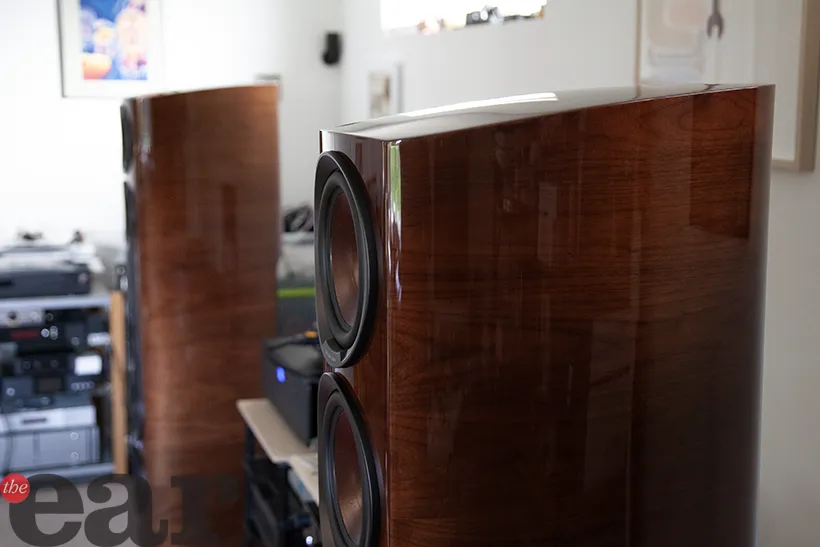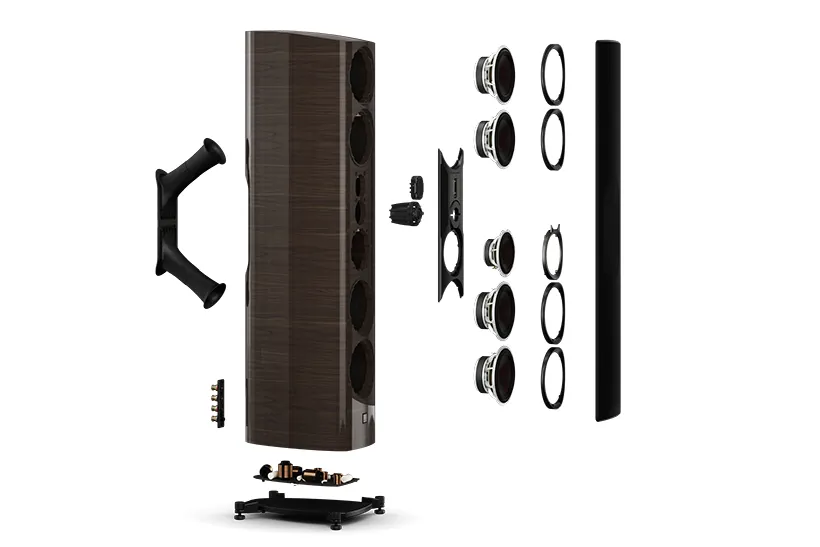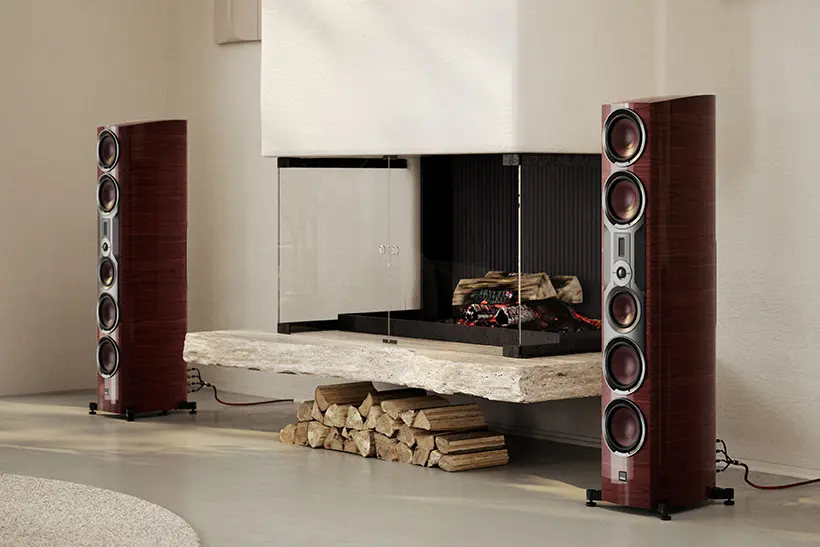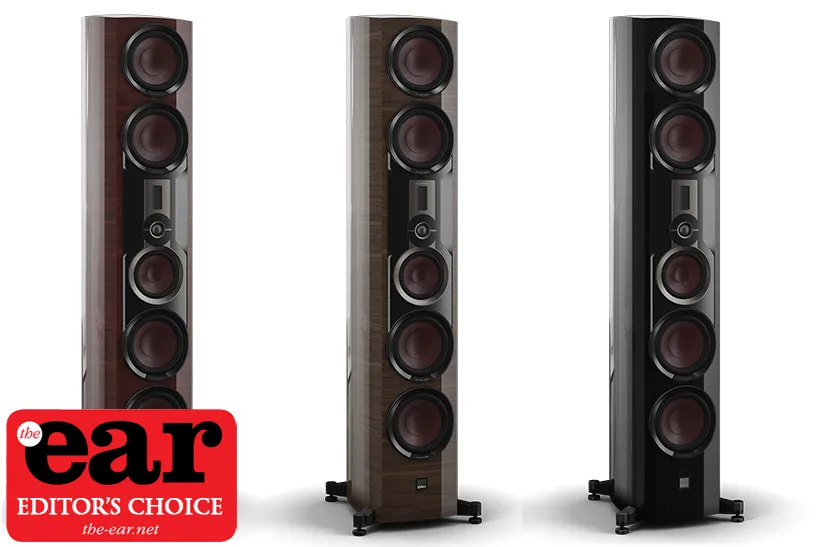Dali Epikore 11 speakers
Dali is not a name that is associated with high end loudspeakers but that’s because they have been so strong at the other end of the market for so long, there has been at least one boundary stretching model in the range for much of the company’s 40 history and of late things have been ramping up in this department. Last year saw the introduction of the most extreme Dali ever in the Kore, a behemoth of a loudspeaker with 11.5inch bass drivers that weighs in at 148 kg (325 lbs). The Epikore 11 was created to fill the chasm between Kore and the rather more approachable Epicon models but is still hardly a lightweight, standing over five feet tall and weighing in at 75 kg per channel. Unless your listening room is as cavernous as that in Dali’s pictures, you’ll know that they are in the room. I have had a few larger speakers in terms of weight but only one that was taller than this and the fact that I sit between three and four metres away means that you do have to close your eyes to get the full benefit.
The Epikore 11 is an advanced loudspeaker with a number of Dali’s key technologies in its drive units, of which there are no fewer than seven. A four and a half way design, the half being the ribbon supertweeter, it runs four eight inch wood fibre bass drivers, a six and a half inch midrange with an embossed pattern to add rigidity in the cone, a 35mm soft dome tweeter and a 55mm ribbon. Key to the quality of the woofers is the use of SMC or soft magnetic compound rather than regular solid magnets. SMC Gen-2 as they are calling it consists of pulverised ferrite, or tiny magnets, where each particle is insulated to stop the complete magnet from being electrically conductive. This compound can be moulded into the required shape and reduces both eddy currents and hysteresis or magnetic memory. The idea comes from diesel injector development and is thus about as far from tweakery as you can imagine.
While the bass drivers are the same in the upper and lower halves of the cabinet the signal that they reproduce is slightly different. The two drivers above the tweeter are rolled off at 170Hz whereas their twins below extend a further 200Hz toward the midrange and roll off at 370Hz. This is part of Dali’s technique for reducing the problems of floor reflections. These reflections are inevitable and cause a cancellation of frequencies in the 250 to 300Hz region according to Dali, this cannot be eliminated with equalisation but by using this difference in crossover points they claim to have “almost completely eliminated” this cancellation. The benefit is said to be that the Epikore 11 delivers a more natural lower midrange.
Dali have developed titanium voice coil formers for the bass and midrange driver, this replaces the aluminium or fibre glass found in more affordable models because it’s stiffer and easier to cool. The strength of the material means that it can have the larger cooling holes that are used in the bass drivers. The large 35mm dome on the tweeter was chosen because it has twice the surface area of a typical 25mm type which allows it to produce more power and integrate more effectively with the midrange unit. Dali have also removed ferrofluid from this tweeter to give it extra freedom, the cooling benefit that this fluid provides not being considered necessary in a dome of this size.
Ribbon tweeter (above) and dome tweeter construction
It hands over to the ribbon at 12.5kHz, this has a hybrid magnet system that combines neodymium, iron and boron for better power handling and has a diecast cap on the back. The thinking is that while ribbons are very good at the highest frequencies they don’t have the power handling of domes, and typically don’t match the vertical dispersion characteristics as well. Dali have offset the latter by limiting vertical dispersion on the dome. Both high frequency drivers and midrange are mounted on an aluminium baffle which is isolated from the cabinet proper in order to reduce energy transmission from the woofers.
The curved wooden cabinet is divided internally into three parts with the midrange having its own chamber and the upper and lower bass systems being separated parts, the latter results in two angled reflex ports from the bass cabinets venting in the centre rear of the boat tail spine. These ports are flared all the way through and devoid of straight lines in order to avoid the ‘organ pipe’ resonance that conventional ports can exhibit. This is not something that you often hear today but interesting that Dali are making the point.
The plinth of the Epikore 11 supports a substantial crossover network that includes inductors with SMC Gen-2 cores, this enables lower DC resistance and less vulnerability to crosstalk compared to air core types and reduced current distortion compared with iron core varieties. Connections on the rear of the cabinet are bi-wire types with chunky aluminium terminals, for single wiring Dali provide jumper cables rather than plates because the latter are not good for sound quality.
In order to keep the Epikore 11 stable and vertical this speaker is supplied with outrigger feet that bolt onto the base and have large conical spikes, but these are a bit too large and blunt to allow the spike to penetrate thick carpets. Spike receptors are provided for those with hard floors, all you or your dealer has to do is get the outriggers fitted and set up these substantial speakers without the spikes meeting unprotected flooring. Being a spike denier I opted to leave both outriggers and spikes in the accessory box.

Epikore 11 sound quality
Listening commenced with my Moor Amps Angel 6 power amplifier but a number of other amplifiers were tried and none appeared to have much difficulty driving what appears to be a benign load. The first thing that strikes you about this loudspeaker is the ease with which it presents music, I suspect that this has a lot to do with SMC but there’s undoubtedly more to it than that. Of course that wouldn’t be so impressive if it wasn’t revealing, there are more than a few laid back speakers around but very few if any of them are as transparent as the Epikore 11.
I haven’t heard many speakers that are on the one hand capable of reproducing the quietest details with so much precision and on the other have so little sense of the mechanical. These big beauties have an effortless transparency that is utterly beguiling when the system is on song, and to be honest they’re pretty damn fabulous when it’s not, but making minor changes to cables or supports is immediately obvious in the way that the sound becomes more three dimensional and open.

The density of detail is massive and yet there are no sharp edges, it makes an awful lot of speakers sound slightly coarse or as if they are having to try too hard. The perceived effect is that distortion is lower than normal, even for a speaker at this price. I haven’t had many big electrostatics in the listening room but the Epikore 11 sound is in that league, albeit with the advantage that it can move more air in the bass than all but the very biggest panels. Turn them up and the sound doesn’t change, the sound pressure changes but there is none of the compression or edginess that tells you that the volume is loud. There is no apparent sense of loudness which is a little dangerous because we rely of that characteristic to let us know when our ears are in danger, here you have to be sensible, or not, if you really want to have fun.
The lack of toe-in creates a very wide soundstage which suits some recordings better than others, live performances expand and fill the room in tremendously realistic fashion but older stereo productions can make the various instruments seem a bit disparate. Especially the ones where individual instruments are only placed in one channel, Bill Evans’ Waltz for Debby is a good example, the drums and bass are in the left channel and the piano in the right, centre stage is left to the audience who clatter their cutlery whilst one of the greatest piano trios that ever played serenades their starters (pearls before swine etc). Yet this does nothing to undermine the beauty of the music, the subtlety and phrasing from Evans and bassist Scott LaFaro in particular is absolutely glorious.

Another nuanced recording is Michael Franks’ The Art of Tea (vinyl by Speakers Corner), this can come across as overly smooth and uneventful but in the Epikore 11’s hands it combines tautness and finesse with superb tone in a soundstage that is replete with fine detail. You don’t need to wind up the volume for that but ZZ Top’s La Grange is a different kettle of electric blues, here the absence of glare in the leading edges encourages excess which is a lot of fun. I was pleasantly surprised by how good the next track on Tres Hombres, Sheik, sounded. This is usually overshadowed but with the Dalis its qualities were immediately apparent, the wah wah solo in particular standing out over a classic locked down rhythm line. This is an important quality for any piece of audio equipment to have, the ability to make your music more appealing by bringing out inner details in a coherent and effortless manner. It proves that Dali have identified what really counts when it comes to loudspeaker design.
With the Ayre EX8 2.0 amplifier the Epikore 11’s sound got a little sweeter, this amp has a Class A sound that’s reflected in a high operating temperature and luscious, spacious tones with juicy bass. It’s not the grippiest of amps but allows the low end to extend down deep without the slightest intrusion from the box, the room or the ports. The Ayre’s balance positively encourages higher playback levels and the full scale, three dimensional imaging that comes with it. I was blown away by Keith Jarrett’s playing on Testament where he improvises on stage in London, this is a very good ECM recording but doesn’t usually offer up as much of the room and the instrument tone, not to mention his feet dancing around on the floor. You can usually here one of them tapping but there is a lot more going on with a speaker that is as transparent and uncoloured as the Epikore 11. Dali call these little details ‘easter eggs’ because they are aural treats that are waiting to be found in so many pieces of music.

I also tried a pair of 50W Class A Valvet monoblocks which produced a very open and even more relaxed sound but failed to provide the small degree of grip that these Dalis require, more successful by far was a Trilogy 921 integrated amp that will be on the site soon. This is a 75W design with a stiff power supply that produced a very revealing if slightly stark sound until I put a DC blocker between it and the power outlet, then it became fluent and resolute, inspiring many hours of listening escape. The result was similar to the Moor Amps inasmuch as there was so much more going on in everything played that familiar tracks became voyages of discovery.
I even took the rather nerdy opportunity of contrasting the various digital versions of Steely Dan’s Time Out of Mind (from Gaucho) to see which was the most appealing, my conclusion was that the version from the Citizen (1993) compilation was the most natural and vinyl like in tonal balance, the PT-SHM CD sounded bright and sprightly while the SHM-CD was a bit loud with excess bass, the last option was an HD tracks 88.2/24 upsampled revision that was small scale but quieter, in a good way. The vinyl will always sound better but it’s an interesting comparison when you have this much resolution on hand.
Conclusion
I am reluctant to let the Dali Epikore 11s go, they are large but not too difficult to move and they make reviewing easier and musical enjoyment even more so. Dali have clearly got a handle on what it takes to make a highly transparent, low colouration loudspeaker that can be driven by affordable amplifiers and works in real world rooms. I suspect that they could do more with a bit more space and more refined amplification but have to say that the experience has been totally engrossing with the system as it is. Put it this way, I will be keeping a much closer eye on Dali loudspeakers in the future, the Epikore 11 has definitely raised expectations.
Type: reflex loaded 4.5-way loudspeaker
Crossover frequencies: 170Hz, 370Hz, 3.1kHz, 12.5kHz
Drive units:
Bass/mid: 4x 8 inch wood-fibre cone, 6.5 inch wood-fibre cone
Tweeter: 35mm fabric dome, 10 x 55mm planar ribbon
Frequency range: 29 – 34,000 Hz (+/-3dB)
Nominal impedance: 4 Ohms
Sensitivity: 89dB @ 2.83v/1m
Connectors: bi-wire binding posts with jumper leads
Dimensions HxWxD: 1602 x 422 x 554mm
Weight: 75.6kg
Finishes: high gloss black, walnut & maroon
Warranty: 5 years
Dali A/S
T +45 9672 1155
https://www.dali-speakers.com
floorstanding loudspeakers
Jason Kennedy
Dali A/S Regional Office
T 01462 337320
https://www.dali-speakers.com


